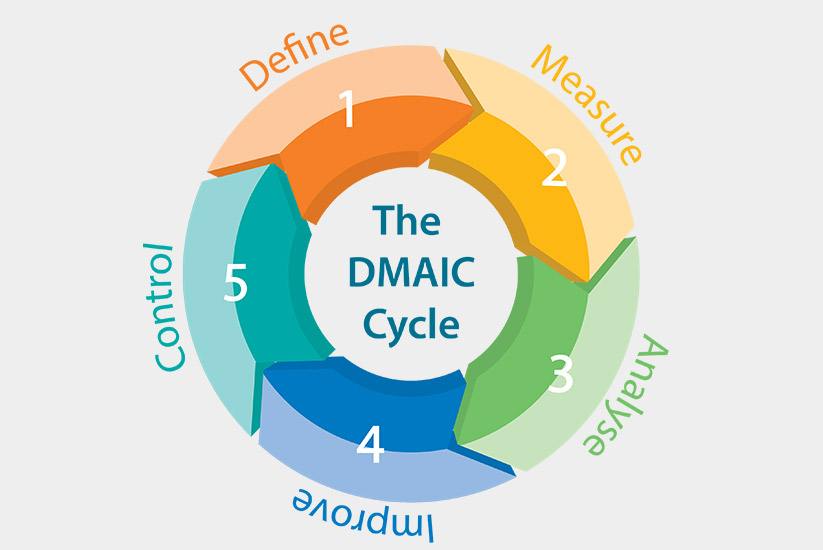Lean Six Sigma is a continuous improvement methodology that focuses on the elimination of waste and reduction of variation from manufacturing, service and design processes. The Lean methodology aims at reducing non-value activities and cycle times while creating value for customers. Accredited Six Sigma Certification Online identifies and reduces variability, improving overall quality. LSS can reduce your costs and help you retain and even gain more customers.
LSS prescribes an improvement process known as DMAIC (Define—Measure—Analyze—Improve—Control). However, its application is limited to improving existing processes. It doesn’t address the design of new products, services, or processes.
For developing a new product, service or process, there’s a modified version called DFSS (Design for Six Sigma). The process most often used in DFSS is called DMADV (Define—Measure—Analyze—Design—Verify).
DMAIC (Define—Measure—Analyze—Improve—Control)

DMAIC is the more well-known and most-used LSS project method. DMAIC focuses on improving an existing process by incorporating the following phases:
- Define: Define the problem, output to be improved, customers, and process associated with the problem.
- Measure: Collect data from the process to establish a baseline for the improvements.
- Analyse: Analyse the data to find the root causes of defects.
- Improve: Develop, test, and implement solutions to improve the process.
- Control: Implement process controls to sustain the improvements.
DMADV (Define—Measure—Analyze—Design—Verify)
DMADV is focused on the process of designing a new product, service or process, incorporating the following phases:
- Define: Define the process and design goals.
- Measure: Measure and identify critical-to-quality characteristics of the product, service or process. This includes risk and production capabilities.
- Analyse: Analyse the data to find the best design.
- Design: Design and test the product, service or process.
- Verify: Ensure that the design output meets the design input requirements (verification) and that the designed product performs satisfactorily under real or simulated conditions of intended use (validation).
DMADVO is a lesser known DFSS method. The difference between DMADV and DMADVO is that “O” or “Optimize” has been added. Thus, DMADVO prioritizes the need for the organization to optimize the design after implementation.

Similarities of DMAIC and DMADV
Except for a few additional features, DMADV and DMAIC are pretty similar to each other. Both have been designed to suit the needs of different companies; however, their main objective is the same.
The aim is to achieve defects less than 3.4 per million opportunities. The aim of both the methodologies is to use statistical methods to find defects causing variations and leading to problems in different processes. Another common feature of the two is that they are aligned to the financial and organization objectives.
Leadership for both involves Champions, Master Black Belts and Black Belts and the success of the project highly depends upon the participation of all process owners.
Differences of DMAIC and DMADV
Though the first three phases are the same, these two methodologies have distinct differences. The DMAIC methodology is mainly associated with defining the business process for the purpose of reduction in variations.
The measure phase involves collecting of data related to current performance of business processes. The DMADV methodology can be seen as a type of DFSS methodology that is concerned with the development of the products or services based on the needs of the customer.
The measures of the DMADV are those in relation to the customer needs and specifications.
Process improvements that are achieved as a result of the DMAIC methodology are based on root cause analysis to find the exact problem areas. The defects can be pinpointed and related to a specific cause leading to the recurrence of the problem.
However, using the DMADV methodology, the efforts emphasize finding options that will fit the requirements of customers and matching their specifications. There is a control system in place to ensure future performance as a part of the DMAIC methodology.
However, DMADV involves the verification stage, which includes simulation tests to verify the efficiency of products according to customer specifications.
Considering the different factors of the two methodologies, companies will be able to differentiate in what would be suitable in which situations. They may even find the need to use both the methodologies if they set out to improve overall business processes and products.
If there appears to be a need to redesign a product from scratch to meet the customer specifications, teams will find using the DMADV methodology better. If the company may need to simply improve existing processes to match standards leading to satisfaction of customer needs, they will find the DMAIC methodology suitable.
When can DMAIC and DMADV be Used?
After identifying the similarities and differences, we can conclude that DMAIC is used on a process or product that already exists, but is unable to meet customer needs or specifications. In comparison, DMADV is used when a new product or process needs to be developed to meet customer requirements. It is also used when a product or process has been optimized using DMAIC, but is still unable to meet customer needs and specifications or the Six Sigma quality levels.
Companies who do not have prior experience in Six Sigma can take help from professionals such as ‘Black Belts’ and ‘Master Black Belts’. They help in making the right choice between DMAIC and DMADV. They also provide help during the implementation stage and this is necessary for the success of any Six Sigma initiative or project.





